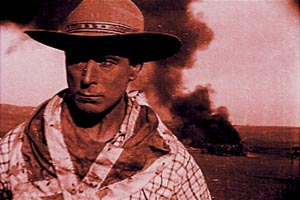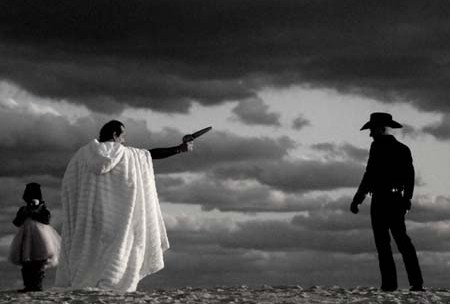
DIRECTED BY: Ji-Woon Kim
FEATURING: Kang-ho Song, Byung-hun Lee, Jung Woo-sung
PLOT: Set in 1930’s Manchuria (during the Japanese occupation of China) and loosely based

on Sergio Leone’s The Good, The Bad, and The Ugly, the film concerns the mad-cap, gunslinging antics of three men in search of a mythical treasure.
WHY IT WON’T MAKE THE LIST: Sure it’s got a fun premise and goofy atmosphere, but the weirdest thing about the film is the “Weird” of the title, who’s primarily a wacky take on Eli Wallach’s “Ugly” character from Leone’s film, with spiky hair and the best jokes in the script. It’s an excellent, peculiar movie, but never reaches List-worthy levels of bizarre.
COMMENTS: Yoon Tae-goo—AKA “The Weird” (Song Kang-ho)—is a resilient petty thief who chances upon a treasure map while robbing a group of Japanese soldiers. Park Chang-yi—AKA “The Bad” (Lee Byun-hun)—is a malicious assassin sent to reclaim the map, who resigns himself to hunting down Tae-goo. Park Do-won—AKA “The Good” (Jung Woo-sung)—is a taciturn bounty hunter chasing after both men’s rewards, who eventually teams up with Tae-goo in the search for the treasure. Sprinkle in some curious Manchurian bandits and a dedicated group of Japanese soldiers, and soon you’ve got an all-out chase replete with wackiness, gunfights, and thrills!
There’s a lot going on in this film, but the sheer enthusiasm that brings it together makes it all completely work. The story is fun and interesting, the action is loud and inventive, the characters are appealing, and the visuals are detailed and colorful. There’s a range of costumes, weapons, and gadgets, giving the movie a slightly anachronistic/steampunk feel. The premise is both an homage to and appropriation of Leone’s original, but infused with its own imaginative mythos and offbeat sense of humor, distinguishing it from a simple remake. The addition of complex Manchurian history involving a multinational conflict gives the story a unique perspective.
The three leads are superb, but Song Kang-ho really owns the film. As “The Weird” he’s hilarious, likable, and unexpectedly capable. Plus, he’s got a secret past! The writers did well to make him the central character, devoting the most time to his story and giving him the best lines. Song is adept at wacky comedy but never slides into flat characterization, making him both engaging and intriguing to watch. Lee Byun-hun as “The Bad” spends most of his time being incredibly badass and looking sharp. Jung Woo-sung as “The Good” is a bit bland, and it doesn’t help that there isn’t much attention paid to his character. He has impressive firearms and his mustache looks silly.
There is very little about this movie to criticize (except perhaps the under-utilization of The Good’s character). With its oft-frenetic pace, out-there stunts, and silly, exuberant atmosphere, it had the audience laughing out loud and gasping at crazy moments in equal measure. The final chase scene at the end is guaranteed to have everyone riveted, while the film itself leaves viewers instinctively smiling from ear-to-ear. I believe the technical critical term is “a rip-roarin’ good time.”
WHAT THE CRITICS SAY:
NOTE: This review is published in slightly different form at Film Forager.



 Greeting the town, Rev. Robert beams a big smile (that smile must have been excruciatingly difficult, and painful, to maintain), but the good reverend clearly becomes nervous as he discovers what he and Faith are up against.
Greeting the town, Rev. Robert beams a big smile (that smile must have been excruciatingly difficult, and painful, to maintain), but the good reverend clearly becomes nervous as he discovers what he and Faith are up against.